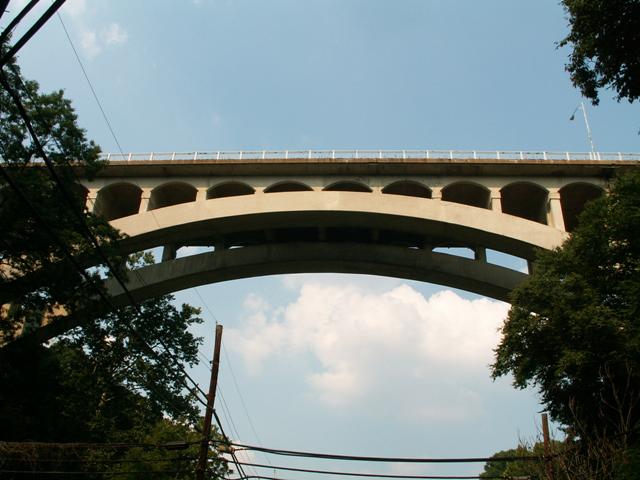We Recommend:
Bach Steel - Experts at historic truss bridge restoration.
BridgeHunter.com Phase 1 is released to the public! - Visit Now
California Avenue Bridge

Primary Photographer(s): Nathan Holth and Rick McOmber
Bridge Documented: August 2, 2007
Pittsburgh: Allegheny County, Pennsylvania: United States
1925 By Builder/Contractor: John F. Casey Company of Pittsburgh, Pennsylvania
Not Available or Not Applicable
320.0 Feet (97.5 Meters)
770.0 Feet (234.7 Meters)
38 Feet (11.58 Meters)
1 Main Span(s) and 14 Approach Span(s)
27301000022710

View Information About HSR Ratings
Bridge Documentation
View Archived National Bridge Inventory Report - Has Additional Details and Evaluation
Pittsburgh has many concrete arch bridges, however this one is particularly noteworthy because unlike many examples, it retains a high degree of historic integrity. The bridge features attractive aesthetic design. On-bridge views, not yet available on this website, include decorative pylons with eagle sculptures and plaques. The arch itself features a design that includes sub-arches that compliment the arch as a whole. The bridge retains original Allegheny County standard plan period railings.
Information and Findings From Pennsylvania's Historic Bridge InventoryDiscussion of Bridge The 15-span, 770'-long bridge built in 1924 is composed of a 320'-long, ribbed, open spandrel arch span and 14 concrete slab approach spans. It is supported on concrete abutments and concrete column and cap beam bents. Plain spandrel columns support concrete floorbeams and a concrete slab deck. The bridge has Allegheny County standard design steel railings. Obelisks topped by eagles are at each corner. The bridge, with its arch crown approximately 140' from the ground, is a long and well-proportioned example of its type and design. It is the most complete of the 13 identified examples in Allegheny County from 1912 to 1950. Many examples have lost their original railings and architectural features. When built, the bridge was the longest of all of the county's open spandrel arch spans. The public works department would continue to push the limits of the technology, eventually culminating in the world's longest example, the George Westinghouse Bridge (1931). The bridge illustrates well the aesthetic appeal of the open spandrel arch type and design in urban settings. The individual historic and technological significance of this example is further enhanced by its setting in an 1880-1930 residential area that appears to be a potential historic district. Discussion of Surrounding Area The viaduct carries a 2 lane street and sidewalks over stream and local road on the Pittsburgh-Bellevue line. It appears to be within a potential historic district composed predominantly Queen Anne and Colonial Revival-style residences from 1880 to 1930 located on both sides of the Jacks Run ravine. The architecturally significant district developed as a railroad/streetcar suburb of Pittsburgh. The only notable infill buildings are four post-WW II residences near the east end of the bridge. The bridge, built within the period of significance, would contribute to the historic district. Bridge Considered Historic By Survey: Yes |
![]()
Photo Galleries and Videos: California Avenue Bridge
Bridge Photo-Documentation
A collection of overview and detail photos. This photo gallery contains a combination of Original Size photos and Mobile Optimized photos in a touch-friendly popup viewer.Alternatively, Browse Without Using Viewer
![]()
Maps and Links: California Avenue Bridge
Coordinates (Latitude, Longitude):
Search For Additional Bridge Listings:
Bridgehunter.com: View listed bridges within 0.5 miles (0.8 kilometers) of this bridge.
Bridgehunter.com: View listed bridges within 10 miles (16 kilometers) of this bridge.
Additional Maps:
Google Streetview (If Available)
GeoHack (Additional Links and Coordinates)
Apple Maps (Via DuckDuckGo Search)
Apple Maps (Apple devices only)
Android: Open Location In Your Map or GPS App
Flickr Gallery (Find Nearby Photos)
Wikimedia Commons (Find Nearby Photos)
Directions Via Sygic For Android
Directions Via Sygic For iOS and Android Dolphin Browser
USGS National Map (United States Only)
Historical USGS Topo Maps (United States Only)
Historic Aerials (United States Only)
CalTopo Maps (United States Only)

